硝酸铁安全技术说明书英文
硝酸铁
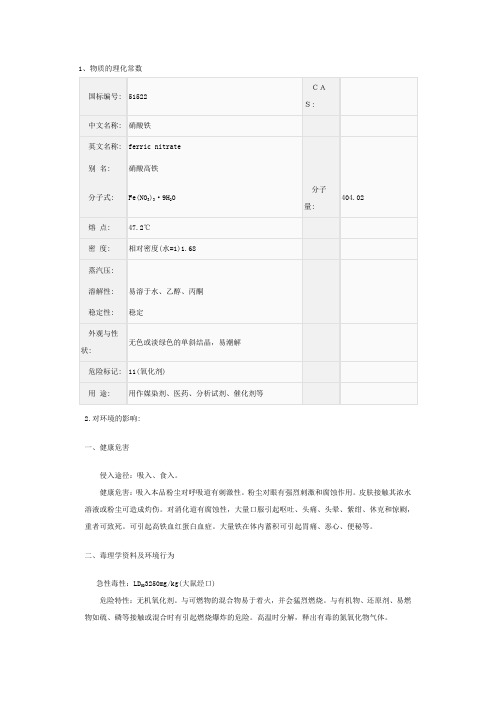
1、物质的理化常数2.对环境的影响:一、健康危害侵入途径:吸入、食入。
健康危害:吸入本品粉尘对呼吸道有刺激性。
粉尘对眼有强烈刺激和腐蚀作用。
皮肤接触其浓水溶液或粉尘可造成灼伤。
对消化道有腐蚀性,大量口服引起呕吐、头痛、头晕、紫绀、休克和惊劂,重者可致死。
可引起高铁血红蛋白血症。
大量铁在体内蓄积可引起胃痛、恶心、便秘等。
二、毒理学资料及环境行为急性毒性:LD503250mg/kg(大鼠经口)危险特性:无机氧化剂。
与可燃物的混合物易于着火,并会猛烈燃烧。
与有机物、还原剂、易燃物如硫、磷等接触或混合时有引起燃烧爆炸的危险。
高温时分解,释出有毒的氮氧化物气体。
燃烧(分解)产物:氮氧化物。
3.现场应急监测方法:水质快速比色管法(日本制,硝酸盐)4.实验室监测方法:酚二磺酸分光光度法(GB7480-87,水质)(硝酸盐)离子色谱法(GB13580.5-92,水质)(硝酸盐)5.环境标准:6.应急处理处置方法:一、泄漏应急处理隔离泄漏污染区,限制出入。
建议应急处理人员戴自给式呼吸器,穿一般作业工作服。
不要直接接触泄漏物。
勿使泄漏物与还原剂、有机物、易燃物或金属粉末接触。
小量泄漏:小心扫起,收集于密闭容光焕发器中做好标记,待处理。
大量泄漏:收集回收或运至废物处理场所处置。
二、防护措施呼吸系统防护:可能接触其粉尘时,应该佩戴头罩型电动送风过滤式防尘呼吸器。
必要时,佩戴自给式呼吸器。
眼睛防护:呼吸系统防护中已作防护。
身体防护:穿聚乙烯防毒服。
手防护:戴橡胶手套。
其它:工作毕,淋浴更衣。
保持良好的卫生习惯。
三、急救措施皮肤接触:立即脱去被污染的衣着,用大量流动清水冲洗,至少15分钟。
就医。
眼睛接触:立即提起眼睑,用大量流动清水或生理盐水彻底冲洗至少15分钟。
就医。
吸入:迅速脱离现场至空气新鲜处。
保持呼吸道通畅。
如呼吸困难,给输氧。
如呼吸停止,立即进行人工呼吸。
就医。
食入:误服者用水漱口,给饮牛奶或蛋清。
就医。
灭火方法:消防人员必须佩戴过滤式防毒面具(全面罩)或隔离式呼吸器、穿全身防火防毒服,在上风处灭火。
硝酸铁(III)九水合物说明书
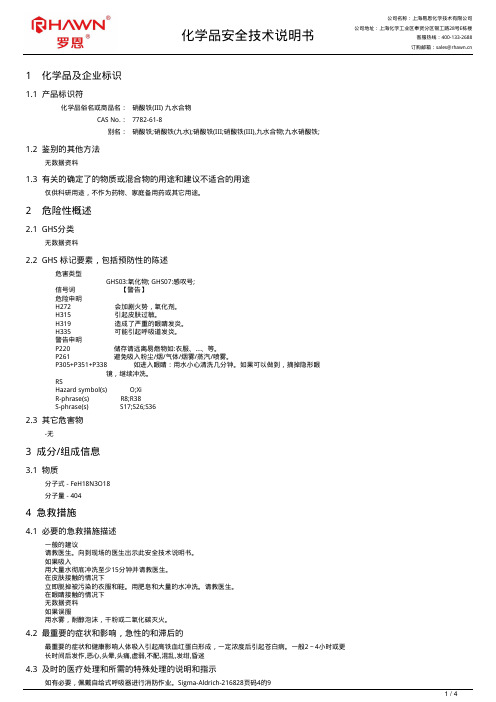
化学品安全技术说明书公司地址:上海化学工业区奉贤分区银工路28号E栋楼客服热线:400-133-2688 1 化学品及企业标识1.1 产品标识符化学品俗名或商品名:硝酸铁(III) 九水合物CAS No.:7782-61-8别名:硝酸铁;硝酸铁(九水);硝酸铁(III;硝酸铁(III),九水合物;九水硝酸铁;1.2 鉴别的其他方法无数据资料1.3 有关的确定了的物质或混合物的用途和建议不适合的用途仅供科研用途,不作为药物、家庭备用药或其它用途。
2 危险性概述2.1 GHS分类无数据资料2.2 GHS 标记要素,包括预防性的陈述危害类型GHS03:氧化物; GHS07:感叹号;信号词 【警告】危险申明H272 会加剧火势,氧化剂。
H315 引起皮肤过敏。
H319 造成了严重的眼睛发炎。
H335 可能引起呼吸道发炎。
警告申明P220 储存请远离易燃物如:衣服、…、等。
P261 避免吸入粉尘/烟/气体/烟雾/蒸汽/喷雾。
P305+P351+P338 如进入眼睛:用水小心清洗几分钟。
如果可以做到,摘掉隐形眼镜,继续冲洗。
RSHazard symbol(s) O;XiR-phrase(s) R8;R38S-phrase(s) S17;S26;S362.3 其它危害物-无3 成分/组成信息3.1 物质分子式 - FeH18N3O18分子量 - 4044 急救措施4.1 必要的急救措施描述一般的建议请教医生。
向到现场的医生出示此安全技术说明书。
如果吸入用大量水彻底冲洗至少15分钟并请教医生。
在皮肤接触的情况下立即脱掉被污染的衣服和鞋。
用肥皂和大量的水冲洗。
请教医生。
在眼睛接触的情况下无数据资料如果误服用水雾,耐醇泡沫,干粉或二氧化碳灭火。
4.2 最重要的症状和影响,急性的和滞后的最重要的症状和健康影响人体吸入引起高铁血红蛋白形成,一定浓度后引起苍白病。
一般2~4小时或更长时间后发作,恶心,头晕,头痛,虚弱,不配,混乱,发绀,昏迷4.3 及时的医疗处理和所需的特殊处理的说明和指示如有必要,佩戴自给式呼吸器进行消防作业。
硝酸铁安全技术说明书
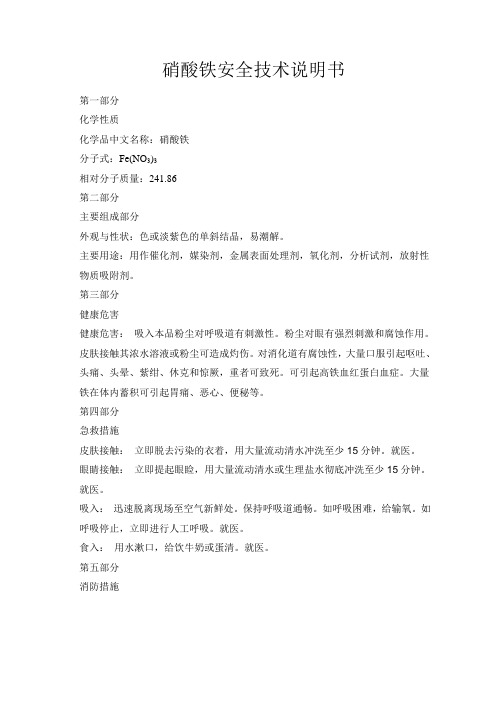
硝酸铁安全技术说明书第一部分化学性质化学品中文名称:硝酸铁分子式:Fe(NO3)3相对分子质量:241.86第二部分主要组成部分外观与性状:色或淡紫色的单斜结晶,易潮解。
主要用途:用作催化剂,媒染剂,金属表面处理剂,氧化剂,分析试剂,放射性物质吸附剂。
第三部分健康危害健康危害:吸入本品粉尘对呼吸道有刺激性。
粉尘对眼有强烈刺激和腐蚀作用。
皮肤接触其浓水溶液或粉尘可造成灼伤。
对消化道有腐蚀性,大量口服引起呕吐、头痛、头晕、紫绀、休克和惊厥,重者可致死。
可引起高铁血红蛋白血症。
大量铁在体内蓄积可引起胃痛、恶心、便秘等。
第四部分急救措施皮肤接触:立即脱去污染的衣着,用大量流动清水冲洗至少15分钟。
就医。
眼睛接触:立即提起眼睑,用大量流动清水或生理盐水彻底冲洗至少15分钟。
就医。
吸入:迅速脱离现场至空气新鲜处。
保持呼吸道通畅。
如呼吸困难,给输氧。
如呼吸停止,立即进行人工呼吸。
就医。
食入:用水漱口,给饮牛奶或蛋清。
就医。
第五部分消防措施危险特性:无机氧化剂。
与可燃物的混合物易于着火,并会猛烈燃烧。
与有机物、还原剂、易燃物如硫、磷等接触或混合时有引起燃烧爆炸的危险。
高温时分解,释出剧毒的氮氧化物气体。
有害燃烧产物:氮氧化物。
灭火方法:消防人员必须佩戴过滤式防毒面具(全面罩)或隔离式呼吸器、穿全身防火防毒服,在上风向灭火。
切勿将水流直接射至熔融物,以免引起严重的流淌火灾或引起剧烈的沸溅。
灭火剂:雾状水、砂土。
第六部分泄漏应急处理隔离泄漏污染区,限制出入。
建议应急处理人员戴防尘面具(全面罩),穿防毒服。
不要直接接触泄漏物。
勿使泄漏物与还原剂、有机物、易燃物或金属粉末接触。
小量泄漏:小心扫起,收集于密闭容器中。
大量泄漏:收集回收或运至废物处理场所处置。
第七部分操作与储存操作注意事项:密闭操作,加强通风。
操作人员必须经过专门培训,严格遵守操作规程。
建议操作人员佩戴头罩型电动送风过滤式防尘呼吸器,穿聚乙烯防毒服,戴橡胶手套。
DFense Blok Fast Cure Hardener化学品安全技术说明书
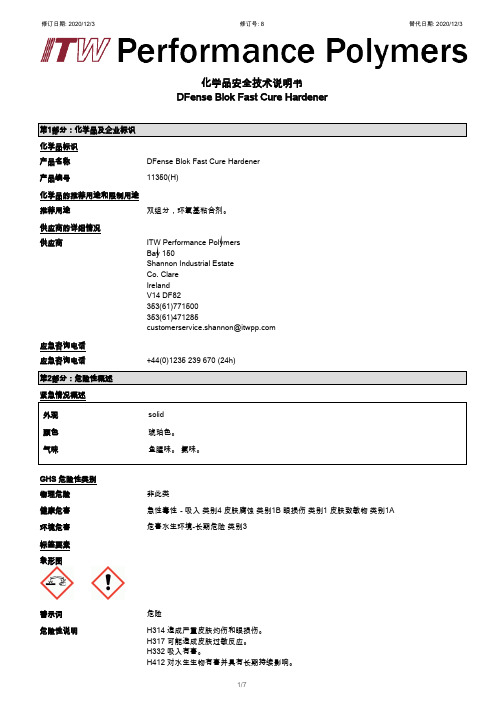
化学品安全技术说明书DFense Blok Fast Cure Hardener化学品标识产品名称DFense Blok Fast Cure Hardener产品编号11350(H)化学品的推荐用途和限制用途推荐用途双组分,环氧基粘合剂。
供应商的详细情况供应商ITW Performance PolymersBay 150Shannon Industrial EstateCo. ClareIrelandV14 DF82353(61)771500353(61)471285应急咨询电话应急咨询电话+44(0)1235 239 670 (24h)紧急情况概述外观solid颜色琥珀色。
气味鱼腥味。
氨味。
GHS 危险性类别物理危险非此类健康危害急性毒性-吸入 类别4 皮肤腐蚀 类别1B 眼损伤 类别1 皮肤致敏物 类别1A 环境危害危害水生环境-长期危险 类别3标签要素象形图警示词危险危险性说明H314 造成严重皮肤灼伤和眼损伤。
H317 可能造成皮肤过敏反应。
H332 吸入有害。
H412 对水生生物有害并具有长期持续影响。
防范说明预防措施P280 戴防护手套/ 穿防护服/ 戴防护眼罩/ 戴防护面具。
事故响应P303+P361+P353 如皮肤(或头发)沾染:立即脱掉所有沾染的衣服。
用水清洗皮肤/ 淋浴。
P305+P351+P338 如进入眼睛: 用水小心冲洗几分钟。
如戴隐形眼镜并可方便地取出,取出隐形眼镜。
继续冲洗。
P308+P313 如接触到或有疑虑:求医/ 就诊。
含有Butadiene acrylonitrile copolymer, 2-PIPERAZIN-1-YLETHYLAMINE,DIETHYLENETRIAMINE, PIPERAZINE所有危险性说明的全文会显示在第16部分。
急救措施描述吸入将受影响的人员转移至新鲜空气处,并注意保暖和呼吸舒适的体位休息。
如果呼吸停止,进行人工呼吸。
MSDS危险化学品安全技术说明书——61023--硝酸铊
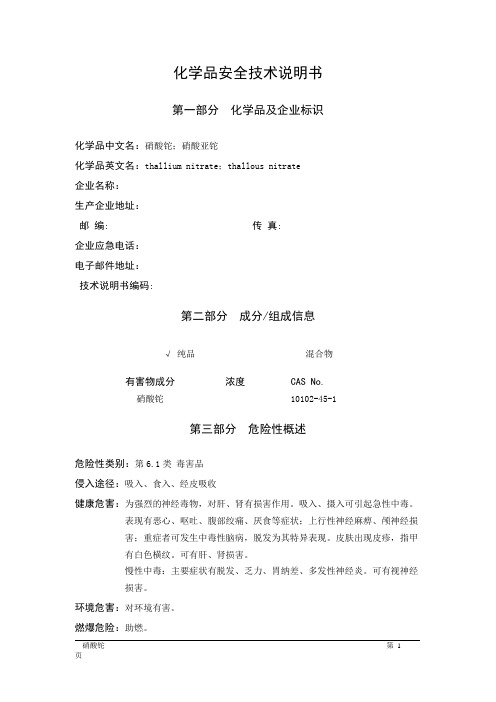
化学品安全技术说明书第一部分化学品及企业标识化学品中文名:硝酸铊;硝酸亚铊化学品英文名:thallium nitrate;thallous nitrate企业名称:生产企业地址:邮编: 传真:企业应急电话:电子邮件地址:技术说明书编码:第二部分成分/组成信息√纯品混合物有害物成分浓度CAS No.硝酸铊10102-45-1第三部分危险性概述危险性类别:第6.1类毒害品侵入途径:吸入、食入、经皮吸收健康危害:为强烈的神经毒物,对肝、肾有损害作用。
吸入、摄入可引起急性中毒。
表现有恶心、呕吐、腹部绞痛、厌食等症状;上行性神经麻痹、颅神经损害;重症者可发生中毒性脑病,脱发为其特异表现。
皮肤出现皮疹,指甲有白色横纹。
可有肝、肾损害。
慢性中毒:主要症状有脱发、乏力、胃纳差、多发性神经炎。
可有视神经损害。
环境危害:对环境有害。
燃爆危险:助燃。
第四部分急救措施皮肤接触:脱去污染的衣着,用大量流动清水冲洗。
如有不适感,就医。
眼睛接触:提起眼睑,用流动清水或生理盐水冲洗。
如有不适感,就医。
吸入:迅速脱离现场至空气新鲜处。
保持呼吸道通畅。
如呼吸困难,给输氧。
呼吸、心跳停止,立即进行心肺复苏术。
就医。
食入:如伤者神志清醒,催吐,洗胃。
用1%碘化钠或1%碘化钾溶液洗胃效果更佳。
口服牛奶、淀粉膏、氢氧化铝凝胶、次碳酸铋。
口服活性碳悬液,用硫酸钠、硫酸镁或蓖麻油导泻。
就医。
第五部分消防措施危险特性:与还原剂、有机物、易燃物如硫、磷或金属粉末等混合可形成爆炸性混合物。
经摩擦、震动或撞击可引起燃烧或爆炸。
有害燃烧产物:无意义。
灭火方法:本品不燃。
根据着火原因选择适当灭火剂灭火。
灭火注意事项及措施:消防人员必须穿全身防火防毒服,在上风向灭火。
尽可能将容器从火场移至空旷处。
喷水保持火场容器冷却,直至灭火结束。
第六部分泄漏应急处理应急行动:隔离泄漏污染区,限制出入。
建议应急处理人员戴防尘口罩,穿防毒服。
勿使泄漏物与可燃物质(如木材、纸、油等)接触。
硝酸锰安全技术说明书英文
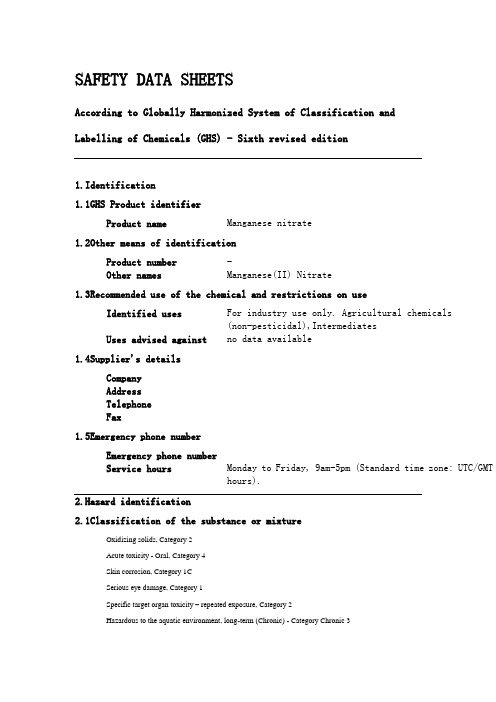
SAFETY DATA SHEETSAccording to Globally Harmonized System of Classification andLabelling of Chemicals (GHS) - Sixth revised edition1.Identification1.1GHS Product identifierProduct name Manganese nitrate1.2Other means of identificationProduct number-Other names Manganese(II) Nitrate1.3Recommended use of the chemical and restrictions on useIdentified uses For industry use only. Agricultural chemicals(non-pesticidal),IntermediatesUses advised against no data available1.4Supplier's detailsCompanyAddressTelephoneFax1.5Emergency phone numberEmergency phone numberService hours Monday to Friday, 9am-5pm (Standard time zone: UTC/GMThours).2.1Classification of the substance or mixtureOxidizing solids, Category 2Acute toxicity - Oral, Category 4Skin corrosion, Category 1CSerious eye damage, Category 1Specific target organ toxicity – repeated exposure, Category 2Hazardous to the aquatic environment, long-term (Chronic) - Category Chronic 32.2GHS label elements, including precautionary statementsPictogram(s)Signal word DangerHazard statement(s)H272 May intensify fire; oxidizerH302 Harmful if swallowedH314 Causes severe skin burns and eye damageH373 May cause damage to organs through prolonged or repeatedexposureH412 Harmful to aquatic life with long lasting effects Precautionarystatement(s)Prevention P210 Keep away from heat, hot surfaces, sparks, open flames andother ignition sources. No smoking.P220 Keep away from clothing and other combustible materials.P280 Wear protective gloves/protective clothing/eyeprotection/face protection.P264 Wash ... thoroughly after handling.P270 Do not eat, drink or smoke when using this product.P260 Do not breathe dust/fume/gas/mist/vapours/spray.P273 Avoid release to the environment.Response P370+P378 In case of fire: Use ... to extinguish.P301+P312 IF SWALLOWED: Call a POISON CENTER/doctor/…if youfeel unwell.P330 Rinse mouth.P301+P330+P331 IF SWALLOWED: Rinse mouth. Do NOT inducevomiting.P303+P361+P353 IF ON SKIN (or hair): Take off immediately allcontaminated clothing. Rinse skin with water [or shower].P363 Wash contaminated clothing before reuse.P304+P340 IF INHALED: Remove person to fresh air and keepcomfortable for breathing.P310 Immediately call a POISON CENTER/doctor/…P321 Specific treatment (see ... on this label).P305+P351+P338 IF IN EYES: Rinse cautiously with water for severalminutes. Remove contact lenses, if present and easy to do. Continuerinsing.P314 Get medical advice/attention if you feel unwell.Storage P405 Store locked up.Disposal P501 Dispose of contents/container to ...2.3Other hazards which do not result in classificationnone3.1Substances4.1Description of necessary first-aid measuresGeneral adviceConsult a physician. Show this safety data sheet to the doctor in attendance.If inhaledIf breathed in, move person into fresh air. If not breathing, give artificial respiration. Consult aphysician.In case of skin contactWash off with soap and plenty of water. Consult a physician.In case of eye contactRinse thoroughly with plenty of water for at least 15 minutes and consult a physician.If swallowedNever give anything by mouth to an unconscious person. Rinse mouth with water. Consult aphysician.4.2Most important symptoms/effects, acute and delayedExcerpt from ERG Guide 140 [Oxidizers]: Inhalation, ingestion or contact (skin, eyes) withvapors or substance may cause severe injury, burns or death. Fire may produce irritating,corrosive and/or toxic gases. Runoff from fire control or dilution water may cause pollution.(ERG, 2016)4.3Indication of immediate medical attention and specialtreatment needed, if necessaryno data available5.1Extinguishing mediaSuitable extinguishing mediaExcerpt from ERG Guide 140 [Oxidizers]: SMALL FIRE: Use water. Do not use dry chemicalsor foams. CO2 or Halon® may provide limited control. LARGE FIRE: Flood fire area withwater from a distance. Do not move cargo or vehicle if cargo has been exposed to heat. Movecontainers from fire area if you can do it without risk. FIRE INVOLVING TANKS ORCAR/TRAILER LOADS: Fight fire from maximum distance or use unmanned hose holders ormonitor nozzles. Cool containers with flooding quantities of water until well after fire is out.ALWAYS stay away from tanks engulfed in fire. For massive fire, use unmanned hose holdersor monitor nozzles; if this is impossible, withdraw from area and let fire burn. (ERG, 2016)5.2Specific hazards arising from the chemicalExcerpt from ERG Guide 140 [Oxidizers]: These substances will accelerate burning wheninvolved in a fire. Some may decompose explosively when heated or involved in a fire. Mayexplode from heat or contamination. Some will react explosively with hydrocarbons (fuels).May ignite combustibles (wood, paper, oil, clothing, etc.). Containers may explode whenheated. Runoff may create fire or explosion hazard. (ERG, 2016)5.3Special protective actions for fire-fightersWear self-contained breathing apparatus for firefighting if necessary.6.1Personal precautions, protective equipment and emergency proceduresUse personal protective equipment. Avoid dust formation. Avoid breathing vapours, mist or gas.Ensure adequate ventilation. Evacuate personnel to safe areas. Avoid breathing dust. Forpersonal protection see section 8.6.2Environmental precautionsPrevent further leakage or spillage if safe to do so. Do not let product enter drains. Dischargeinto the environment must be avoided.6.3Methods and materials for containment and cleaning upPick up and arrange disposal. Sweep up and shovel. Keep in suitable, closed containers fordisposal.7.1Precautions for safe handlingAvoid contact with skin and eyes. Avoid formation of dust and aerosols. Avoid exposure -obtain special instructions before use.Provide appropriate exhaust ventilation at places wheredust is formed. For precautions see section 2.2.7.2Conditions for safe storage, including any incompatibilitiesStore in cool place. Keep container tightly closed in a dry and well-ventilated place.8.1Control parametersOccupational Exposure limit valuesno data availableBiological limit valuesno data available8.2Appropriate engineering controlsHandle in accordance with good industrial hygiene and safety practice. Wash hands beforebreaks and at the end of workday.8.3Individual protection measures, such as personal protective equipment (PPE)Eye/face protectionSafety glasses with side-shields conforming to EN166. Use equipment for eye protection testedand approved under appropriate government standards such as NIOSH (US) or EN 166(EU).Skin protectionWear impervious clothing. The type of protective equipment must be selected according to theconcentration and amount of the dangerous substance at the specific workplace. Handle withgloves. Gloves must be inspected prior to use. Use proper glove removal technique(withouttouching glove's outer surface) to avoid skin contact with this product. Dispose of contaminatedgloves after use in accordance with applicable laws and good laboratory practices. Wash anddry hands. The selected protective gloves have to satisfy the specifications of EU Directive89/686/EEC and the standard EN 374 derived from it.Respiratory protectionWear dust mask when handling large quantities.Thermal hazardsno data availablePhysical state CLEAR, PALE-RED LIQUIDColour no data availableOdour no data availableMelting point/ freezing37ºCpointBoiling point or initial 100ºCboiling point and boilingrangeFlammability no data availableno data availableLower and upper explosionlimit / flammabilitylimitFlash point no data availableno data availableAuto-ignitiontemperatureno data availableDecompositiontemperaturepH no data availableKinematic viscosity no data availableSolubility In water:solubleno data availablePartition coefficientn-octanol/water (logvalue)Vapour pressure no data availableDensity and/or relative1.536g/mLat 25°CdensityRelative vapour density no data availableParticle characteristics n o data available10.1Reactivityno data available10.2Chemical stabilityStable under recommended storage conditions.10.3Possibility of hazardous reactionsMixtures of metal/nonmetal nitrates with alkyl esters may explode, owing to the formation ofalkyl nitrates; mixtures of nitrate with phosphorus, tin (II) chloride, or other reducing agentsmay react explosively [Bretherick 1979. p. 108-109]. The anhydrous nitrate salt with ureaexplodes upon heating, [Chem Abs., 1975, 82, 48151].10.4Conditions to avoidno data available10.5Incompatible materialsno data available10.6Hazardous decomposition productsno data availableAcute toxicity•Oral: no data available•Inhalation: no data available•Dermal: no data availableSkin corrosion/irritationno data availableSerious eye damage/irritationno data availableRespiratory or skin sensitizationno data availableGerm cell mutagenicityno data availableCarcinogenicityno data availableReproductive toxicityno data availableSTOT-single exposureno data availableSTOT-repeated exposureno data availableAspiration hazardno data available12.1Toxicity•Toxicity to fish: no data available•Toxicity to daphnia and other aquatic invertebrates: no data available •Toxicity to algae: no data available•Toxicity to microorganisms: no data available12.2Persistence and degradabilityno data available12.3Bioaccumulative potential12.4Mobility in soilno data available12.5Other adverse effectsno data available13.1Disposal methodsProductThe material can be disposed of by removal to a licensed chemical destruction plant or bycontrolled incineration with flue gas scrubbing. Do not contaminate water, foodstuffs, feed orseed by storage or disposal. Do not discharge to sewer systems.Contaminated packagingContainers can be triply rinsed (or equivalent) and offered for recycling or reconditioning.Alternatively, the packaging can be punctured to make it unusable for other purposes and thenbe disposed of in a sanitary landfill. Controlled incineration with flue gas scrubbing is possiblefor combustible packaging materials.14.1UN NumberADR/RID: UN3264IMDG: UN3264IATA: UN3264 14.2UN Proper Shipping NameADR/RID: CORROSIVE LIQUID, ACIDIC, INORGANIC, N.O.S.IMDG: CORROSIVE LIQUID, ACIDIC, INORGANIC, N.O.S.IATA: CORROSIVE LIQUID, ACIDIC, INORGANIC, N.O.S.14.3Transport hazard class(es)ADR/RID: 8IMDG: 8IATA: 8 14.4Packing group, if applicableADR/RID: III IMDG: III IATA: III 14.5Environmental hazardsADR/RID: no IMDG: no IATA: no 14.6Special precautions for userno data available14.7Transport in bulk according to Annex II of MARPOL 73/78 andthe IBC Code15.1Safety, health and environmental regulations specific for the product in questionInformation on revisionCreation Date Aug 12, 2017Revision Date Aug 12, 2017Abbreviations and acronyms•CAS: Chemical Abstracts Service•ADR: European Agreement concerning the International Carriage of Dangerous Goods by Road •RID: Regulation concerning the International Carriage of Dangerous Goods by Rail•IMDG: International Maritime Dangerous Goods•IATA: International Air Transportation Association•TWA: Time Weighted Average•STEL: Short term exposure limit•LC50: Lethal Concentration 50%•LD50: Lethal Dose 50%•EC50: Effective Concentration 50%Disclaimer: The above information is believed to be correct but does not purportto be all inclusive and shall be used only as a guide. The information in this documentis based on the present state of our knowledge and is applicable to the product withregard to appropriate safety precautions. It does not represent any guarantee ofthe properties of the product. We as supplier shall not be held liable for any damageresulting from handling or from contact with the above product.。
硝酸铁安全技术说明书MSDS
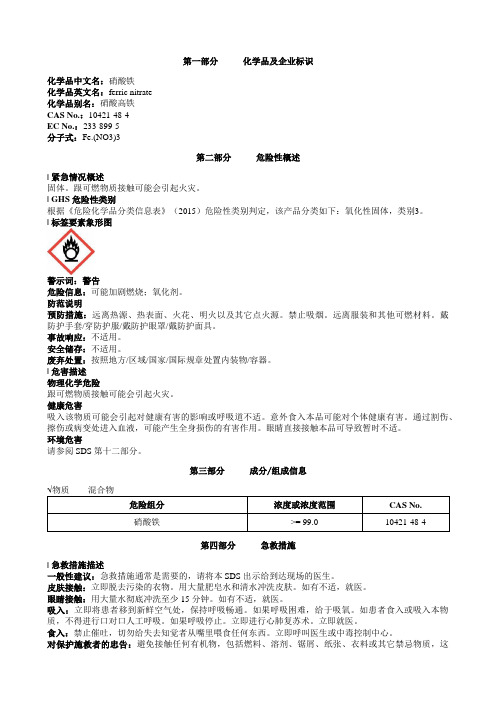
第一部分化学品及企业标识化学品中文名:硝酸铁化学品英文名:ferric nitrate化学品别名:硝酸高铁CAS No.:10421-48-4EC No.:233-899-5分子式:Fe.(NO3)3第二部分危险性概述| 紧急情况概述固体。
跟可燃物质接触可能会引起火灾。
| GHS 危险性类别根据《危险化学品分类信息表》(2015)危险性类别判定,该产品分类如下:氧化性固体,类别3。
| 标签要素象形图警示词:警告危险信息:可能加剧燃烧;氧化剂。
防范说明预防措施:远离热源、热表面、火花、明火以及其它点火源。
禁止吸烟。
远离服装和其他可燃材料。
戴防护手套/穿防护服/戴防护眼罩/戴防护面具。
事故响应:不适用。
安全储存:不适用。
废弃处置:按照地方/区域/国家/国际规章处置内装物/容器。
| 危害描述物理化学危险跟可燃物质接触可能会引起火灾。
健康危害吸入该物质可能会引起对健康有害的影响或呼吸道不适。
意外食入本品可能对个体健康有害。
通过割伤、擦伤或病变处进入血液,可能产生全身损伤的有害作用。
眼睛直接接触本品可导致暂时不适。
环境危害请参阅 SDS 第十二部分。
第三部分成分/组成信息第四部分急救措施| 急救措施描述一般性建议:急救措施通常是需要的,请将本 SDS 出示给到达现场的医生。
皮肤接触:立即脱去污染的衣物。
用大量肥皂水和清水冲洗皮肤。
如有不适,就医。
眼睛接触:用大量水彻底冲洗至少 15 分钟。
如有不适,就医。
吸入:立即将患者移到新鲜空气处,保持呼吸畅通。
如果呼吸困难,给于吸氧。
如患者食入或吸入本物质,不得进行口对口人工呼吸。
如果呼吸停止。
立即进行心肺复苏术。
立即就医。
食入:禁止催吐,切勿给失去知觉者从嘴里喂食任何东西。
立即呼叫医生或中毒控制中心。
对保护施救者的忠告:避免接触任何有机物,包括燃料、溶剂、锯屑、纸张、衣料或其它禁忌物质,这些物质都可以引起点燃。
清除所有火源,增强通风。
避免接触皮肤和眼睛。
避免吸入粉尘。
碘酸铁安全技术说明书msds
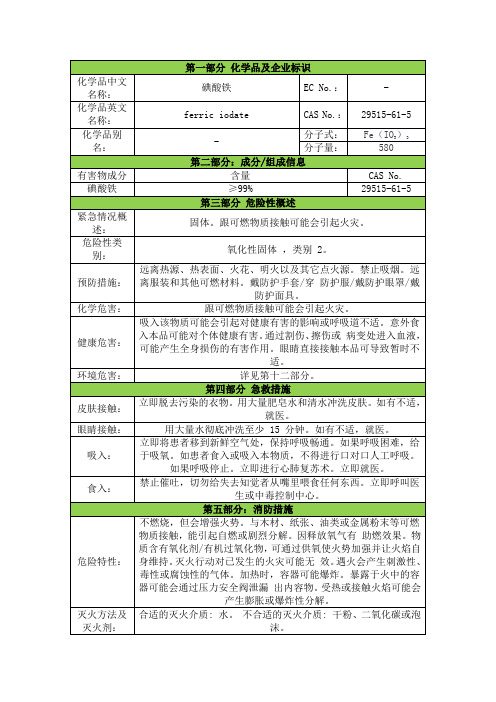
【7】美国交通部:应急响应指南
【8】德国GESTIS-有害物质数据库
免责声明
本安全技术说明书格式符合我国 GB/T16483 和 GB/T17519 要求,数据来源于国际权威数据库和企业提交的数据,其它的信息是基于本人目前所掌握的知识。尽量保证其中所有信息的正确性,但由于信息来源的多样性以及本人所掌握知识的局限性,本文件仅供使用者参考。安全技术说明书的使用者应根据使用目的,对相关信息的合理性做出判断。我们对该产品操作、存储、使用或处置等环节产生的任何损害,不承担任何责任。
环境危害:
详见第十二部分。
第四部分 急救措施
皮肤接触:
立即脱去污染的衣物。用大量肥皂水和清水冲洗皮肤。如有不适,就医。
眼睛接触:
用大量水彻底冲洗至少 15 分钟。如有不适,就医。
吸入:
立即将患者移到新鲜空气处,保持呼吸畅通。如果呼吸困难,给于吸氧。如患者食入或吸入本物质,不得进行口对口人工呼吸。如果呼吸停止。立即进行心肺复苏术。立即就医。
皮肤致敏:
无资料
呼吸致敏:
无资料
生殖细胞突变性:
无资料
生殖毒性:
无资料
特异性靶器官系统毒性--一次接触可能:
无资料
特异性靶器官系统毒性--反复接:
无资料
吸入危害:
无资料
第十二部分 生态学资料
急性水性毒性:
鱼类:LC50:无资料
甲壳纲动物:EC50:无资料
藻类/水生植物:ErC50:无资料
慢性水生毒性:
禁配物:
无资料
避免接触的条件:
不相容物质,热、火ຫໍສະໝຸດ 和火花。聚合危害:无资料
分解产物:
硝酸亚汞安全技术说明书英文
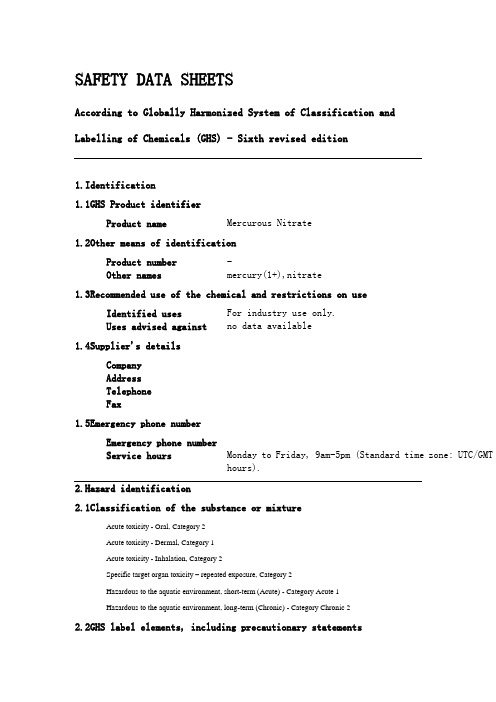
SAFETY DATA SHEETSAccording to Globally Harmonized System of Classification andLabelling of Chemicals (GHS) - Sixth revised edition1.Identification1.1GHS Product identifierProduct name Mercurous Nitrate1.2Other means of identificationProduct number-Other names mercury(1+),nitrate1.3Recommended use of the chemical and restrictions on useIdentified uses For industry use only.Uses advised against no data available1.4Supplier's detailsCompanyAddressTelephoneFax1.5Emergency phone numberEmergency phone numberService hours Monday to Friday, 9am-5pm (Standard time zone: UTC/GMThours).2.1Classification of the substance or mixtureAcute toxicity - Oral, Category 2Acute toxicity - Dermal, Category 1Acute toxicity - Inhalation, Category 2Specific target organ toxicity – repeated exposure, Category 2Hazardous to the aquatic environment, short-term (Acute) - Category Acute 1Hazardous to the aquatic environment, long-term (Chronic) - Category Chronic 22.2GHS label elements, including precautionary statementsPictogram(s)Signal word DangerHazard statement(s)H300 Fatal if swallowedH310 Fatal in contact with skinH330 Fatal if inhaledH373 May cause damage to organs through prolonged or repeatedexposureH400 Very toxic to aquatic lifeH410 Very toxic to aquatic life with long lasting effects Precautionarystatement(s)Prevention P264 Wash ... thoroughly after handling.P270 Do not eat, drink or smoke when using this product.P262 Do not get in eyes, on skin, or on clothing.P280 Wear protective gloves/protective clothing/eyeprotection/face protection.P260 Do not breathe dust/fume/gas/mist/vapours/spray.P271 Use only outdoors or in a well-ventilated area.P284 [In case of inadequate ventilation] wear respiratory protection.P273 Avoid release to the environment.Response P301+P310 IF SWALLOWED: Immediately call a POISONCENTER/doctor/…P321 Specific treatment (see ... on this label).P330 Rinse mouth.P302+P352 IF ON SKIN: Wash with plenty of water/...P310 Immediately call a POISON CENTER/doctor/…P361+P364 Take off immediately all contaminated clothing and washit before reuse.P304+P340 IF INHALED: Remove person to fresh air and keepcomfortable for breathing.P320 Specific treatment is urgent (see ... on this label).P314 Get medical advice/attention if you feel unwell.P391 Collect spillage.Storage P405 Store locked up.P403+P233 Store in a well-ventilated place. Keep container tightlyclosed.Disposal P501 Dispose of contents/container to ...2.3Other hazards which do not result in classificationnone3.1Substances4.1Description of necessary first-aid measuresGeneral adviceConsult a physician. Show this safety data sheet to the doctor in attendance.If inhaledIf breathed in, move person into fresh air. If not breathing, give artificial respiration. Consult aphysician.In case of skin contactWash off with soap and plenty of water. Consult a physician.In case of eye contactRinse thoroughly with plenty of water for at least 15 minutes and consult a physician.If swallowedNever give anything by mouth to an unconscious person. Rinse mouth with water. Consult aphysician.4.2Most important symptoms/effects, acute and delayedAcute systemic poisoning may be fatal within a few minutes; death by uremic poisoning isusually delayed 5-12 days. Acute poisoning has resulted from inhaling dust concentrations of1.2-8.5 mg/m 3 of air; symptoms inc lude tightness and pain in chest, coughing, and difficultyin breathing. Ingestion causes necrosis, pain, vomiting, and severe purging. Contact with eyescauses ulceration of conjunctiva and cornea. Contact with skin causes irritation and po ssibledermatitis; systemic poisoning can occur by absorption through skin. (USCG, 1999)4.3Indication of immediate medical attention and specialtreatment needed, if necessaryno data available5.1Extinguishing mediaSuitable extinguishing mediaIf material on fire or involved in fire: Extinguish fire using agent suitable for type ofsurrounding fire. (Material itself does not burn or burns with difficulty.) Use foam, drychemical, or carbon dioxide. Keep run-off water out of sewers and water sources.5.2Specific hazards arising from the chemicalSpecial Hazards of Combustion Products: Smoke from fire may contain toxic mercury vaporand oxides of nitrogen. Behavior in Fire: May increase intensity of fire (USCG, 1999)5.3Special protective actions for fire-fightersWear self-contained breathing apparatus for firefighting if necessary.6.1Personal precautions, protective equipment and emergency proceduresUse personal protective equipment. Avoid dust formation. Avoid breathing vapours, mist or gas.Ensure adequate ventilation. Evacuate personnel to safe areas. Avoid breathing dust. Forpersonal protection see section 8.6.2Environmental precautionsPrevent further leakage or spillage if safe to do so. Do not let product enter drains. Dischargeinto the environment must be avoided.6.3Methods and materials for containment and cleaning upEnvironmental considerations: Land spill: Dig a pit, pond, lagoon, holding area to containliquid or solid material. /SRP: If time permits, pits, ponds, lagoons, soak holes, or holding areasshould be sealed with an impermeable flexible membrane liner./ Cover solids with a plasticsheet to prevent dissolving in rain or fire fighting water.7.1Precautions for safe handlingAvoid contact with skin and eyes. Avoid formation of dust and aerosols. Avoid exposure -obtain special instructions before use.Provide appropriate exhaust ventilation at places wheredust is formed. For precautions see section 2.2.7.2Conditions for safe storage, including any incompatibilitiesStorage temp: ambient8.1Control parametersOccupational Exposure limit valuesRecommended Exposure Limit: 10 Hr Time-Weighted Avg: 0.05 mg/cu m, skin (Hg vapor)./Mercury [except (organo) alkyls] (as Hg)/Recommended Exposure Limit: Ceiling Value: 0.1 mg/cu m, skin. /Mercury compounds[except (organo) alkyls] (as Hg)/Biological limit valuesno data available8.2Appropriate engineering controlsHandle in accordance with good industrial hygiene and safety practice. Wash hands beforebreaks and at the end of workday.8.3Individual protection measures, such as personal protectiveequipment (PPE)Eye/face protectionSafety glasses with side-shields conforming to EN166. Use equipment for eye protection testedand approved under appropriate government standards such as NIOSH (US) or EN 166(EU).Skin protectionWear impervious clothing. The type of protective equipment must be selected according to theconcentration and amount of the dangerous substance at the specific workplace. Handle withgloves. Gloves must be inspected prior to use. Use proper glove removal technique(withouttouching glove's outer surface) to avoid skin contact with this product. Dispose of contaminatedgloves after use in accordance with applicable laws and good laboratory practices. Wash anddry hands. The selected protective gloves have to satisfy the specifications of EU Directive89/686/EEC and the standard EN 374 derived from it.Respiratory protectionWear dust mask when handling large quantities.Thermal hazardsno data availablePhysical state Mercurous nitrate is a white solid. Usually exists as tdihydrate. Toxic by ingestion.Colour Solid, whiteOdour Slight odor of nitric acidno data availableMelting point/ freezingpointBoiling point or initial83ºC at 760mmHgboiling point and boilingrangeFlammability no data availableno data availableLower and upper explosionlimit / flammabilitylimitFlash point no data availableno data availableAuto-ignitiontemperatureno data availableDecompositiontemperaturepH no data availableKinematic viscosity no data availableSolubility Water-solubleno data availablePartition coefficientn-octanol/water (logvalue)Vapour pressure no data availableDensity and/or relative4.78 at 20°C (USCG, 1999)densityRelative vapour density no data availableParticle characteristics n o data available10.1Reactivityno data available10.2Chemical stabilityStable under recommended storage conditions.10.3Possibility of hazardous reactionsSolution in contact with wood or paper may cause fire. May increase the intensity offire.Mixtures of metal/nonmetal nitrates with alkyl esters may explode, owing to the formation of alkyl nitrates; mixtures with phosphorus, tin (II) chloride or other reducing agents may react explosively [Bretherick 1979. p. 108-109].10.4Conditions to avoidno data available10.5Incompatible materialsSolid in contact with wood or paper may cause fire.10.6Hazardous decomposition productsSmoke from fire may contain toxic mercury & oxides of nitrogen.Acute toxicity•Oral: no data available•Inhalation: no data available•Dermal: no data availableSkin corrosion/irritationno data availableSerious eye damage/irritationno data availableRespiratory or skin sensitizationno data availableGerm cell mutagenicityno data availableCarcinogenicityA4: Not classifiable as a human carcinogen. /Mercury, elemental and inorganic forms, as Hg/Reproductive toxicityno data availableSTOT-single exposureno data availableSTOT-repeated exposureno data availableAspiration hazardno data available12.1Toxicity•Toxicity to fish: no data available•Toxicity to daphnia and other aquatic invertebrates: no data available•Toxicity to algae: no data available•Toxicity to microorganisms: no data available12.2Persistence and degradabilityno data available12.3Bioaccumulative potential12.4Mobility in soilno data available12.5Other adverse effectsno data available13.1Disposal methodsProductThe material can be disposed of by removal to a licensed chemical destruction plant or bycontrolled incineration with flue gas scrubbing. Do not contaminate water, foodstuffs, feed orseed by storage or disposal. Do not discharge to sewer systems.Contaminated packagingContainers can be triply rinsed (or equivalent) and offered for recycling or reconditioning.Alternatively, the packaging can be punctured to make it unusable for other purposes and thenbe disposed of in a sanitary landfill. Controlled incineration with flue gas scrubbing is possiblefor combustible packaging materials.14.1UN NumberADR/RID: UN1627IMDG: UN1627IATA: UN1627 14.2UN Proper Shipping NameADR/RID: MERCUROUS NITRATEIMDG: MERCUROUS NITRATEIATA: MERCUROUS NITRATE14.3Transport hazard class(es)ADR/RID: 6.1(a)IMDG: 6.1(a)IATA: 6.1(a) 14.4Packing group, if applicableADR/RID: II IMDG: II IATA: II 14.5Environmental hazardsADR/RID: yes IMDG: yes IATA: yes 14.6Special precautions for userno data available14.7Transport in bulk according to Annex II of MARPOL 73/78 andthe IBC Code15.1Safety, health and environmental regulations specific for the product in questionInformation on revisionCreation Date Aug 10, 2017Revision Date Aug 10, 2017Abbreviations and acronyms•CAS: Chemical Abstracts Service•ADR: European Agreement concerning the International Carriage of Dangerous Goods by Road •RID: Regulation concerning the International Carriage of Dangerous Goods by Rail•IMDG: International Maritime Dangerous Goods•IATA: International Air Transportation Association•TWA: Time Weighted Average•STEL: Short term exposure limit•LC50: Lethal Concentration 50%•LD50: Lethal Dose 50%•EC50: Effective Concentration 50%Disclaimer: The above information is believed to be correct but does not purportto be all inclusive and shall be used only as a guide. The information in this documentis based on the present state of our knowledge and is applicable to the product withregard to appropriate safety precautions. It does not represent any guarantee ofthe properties of the product. We as supplier shall not be held liable for any damageresulting from handling or from contact with the above product.。
硝酸铁--MSDS-安全技术说明书
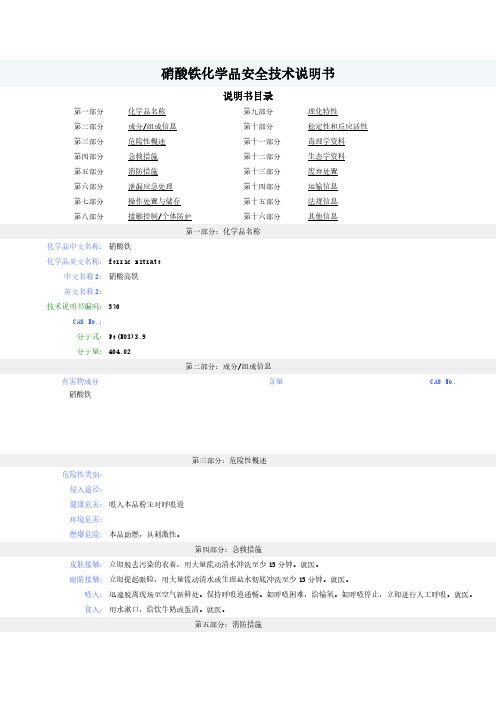
第八部分:接触控制/个体防护 职业接触限值 中国 MAC(mg/m3): 未制定标准 前苏联 MAC(mg/m3): 未制定标准
TLVTN: 未制定标准 TLVWN: 未制定标准 监测方法: 工程控制: 生产过程密闭,加强通 呼吸系统防护: 可能接触其粉尘时,应 眼睛防护: 呼吸系统防护中已作防 身体防护: 穿聚乙烯防毒服。 手防护: 戴橡胶手套。 其他防护: 工作完毕,淋浴更衣。
LC50:无资料 亚急性和慢性毒性:
刺激性: 致敏性: 致突变性: 致畸性: 致癌性:
第十二部分:生态学资料 生态毒理毒性:
生物降解性: 非生物降解性: 生物富集或生物积累性: 其它有害作用: 该物质对环境可能有危害,在地下水中有蓄积作用。
第十三部分:废弃处置 废弃物性质: 废弃处置方法: 根据国家和地方有关法 废弃注意事项:
爆炸下限%(V/V): 无意义 溶解性: 易溶于水、乙醇、丙酮。
主要用途: 用作媒染剂、医药、分 其它理化性质: 125
第十部分:稳定性和反应活性 稳定性: 禁配物: 易燃或可燃物、强还原 避免接触的条件: 潮湿空气。 聚合危害: 分解产物:
第十一部分:毒理学资料 急性毒性: LD50:3250 mg/kg(大鼠经口)
硝酸铁化学品安全技术说明书
说明书目录
第一部分
化学品名称
第九部分
第二部分
成分/组成信息
第十部分
第三部分
危险性概述
第十一部分
第四部分
急救措施
第十二部分
第五部分
消防措施
第十三部分
第六部分
泄漏应急处理
化学品安全技术说明书(MSDS)中英文对照及翻译完整版

化学品安全技术说明书(MSDS)中英文对照及翻译完整版各位读友大家好,此文档由网络收集而来,欢迎您下载,谢谢篇一:化学品安全技术说明MSDS-亚硫酸氢钠(中英文对照版本)Sodium Bisulfite1) Chemical Product and Company IdentificationMSDS Name: Sodium Sulfite, AnhydrousCatalog Numbers: S80195, 1MSS44-20, 1MSS4420, BP355 500, BP355-500, BP355500, S430 10, S430 3, S430 500, S430-10, S430-3, S430-500, S43010, S4303, S430500, S447 3, S447 500, S447-3, S447-500, S4473, S447500 Synonyms: Sulfurous acid, disodium saltRisk Phrases: 22 36/37/383) Hazards IdentificationEMERGENCY OVERVIEWAppearance: white. Air sensitive. Moisture sensitive. Warning! Causes eye and skin irritation. May cause digestive tract irritation. Causes respiratory tract irritation. May be harmful if swallowed.Target Organs: Central nervous system.Potential Health EffectsEye: Causes eye irritation. May cause chemical conjunctivitis.Skin: Causes skin irritation.Ingestion: May cause gastrointestinal irritation with nausea, vomiting and diarrhea. May be harmful if swallowed.Inhalation: Causes respiratory tract irritation. Can produce delayed pulmonary edema.Chronic: Effects may be delayed.4) First Aid MeasuresEyes: Flush eyes with plenty of water for at least 15 minutes, occasionally lifting the upper and lower eyelids. Get medical aid.Skin: Get medical aid. Flush skin with plenty of soap and water for at least 15 minutes while removing contaminated clothing and shoes. Wash clothing before reuse.Ingestion: If victim is conscious and alert, give 2-4 cupfuls of milk or water. Never give anything by mouth to an unconscious person. Get medical aid immediately.Inhalation: Remove from exposure to fresh air immediately. If not breathing, give artificial respiration. If breathing is difficult, give oxygen. Get medical aid. Notes to Physician: Treat symptomatically and supportively.5) Fire Fighting MeasuresGeneral Information: As in any fire,wear a self-contained breathing apparatus in pressure-demand, MSHA/NIOSH (approved or equivalent), and full protective gear. During a fire, irritating and highly toxic gases may be generated by thermal decomposition or combustion. Wear appropriate protective clothing to prevent contact with skin and eyes. Wear a self-contained breathing apparatus (SCBA) to prevent contact with thermal decomposition products.Extinguishing Media: Substance is noncombustible; use agent most appropriate to extinguish surrounding fire. Do NOT get water inside containers. Use water spray, dry chemical, carbon dioxide, or appropriate foam.6) Accidental Release MeasuresGeneral Information: Use proper personal protective equipment as indicated in Section 8.Spills/Leaks: Vacuum or sweep upmaterial and place into a suitable disposal container. Clean up spills immediately, observing precautions in the Protective Equipment section. Avoid generating dusty conditions. Provide ventilation. Place under an inert atmosphere. Do not get water inside containers.7) Handling and StorageHandling: Wash thoroughly after handling. Use with adequate ventilation. Minimize dust generation and accumulation. Avoid contact with eyes, skin, and clothing. Keep container tightly closed. Avoid ingestion and inhalation. Handle under an inert atmosphere. Store protected from air. Do not allow contact with water. Wash clothing before reuse. Keep from contact with moist air and steam.Storage: Store in a tightly closed container. Keep from contact with oxidizing materials. Store in a cool, dry,well-ventilated area away from incompatible substances. Keep away from strong acids. Do not expose to air. Store protected from moisture. Store under an inert atmosphere.8) Exposure Controls, Personal ProtectionEngineering Controls: Facilities storing or utilizing this material should be equipped with an eyewash facility and a safety shower. Use adequate ventilation to keep airborne concentrations low.listed for this chemical.Personal Protective EquipmentEyes: Wear appropriate protective eyeglasses or chemical safety goggles as described by OSHA’s eye and face protection regulations in 29 CFR or European Standard EN166.Skin: Wear appropriate protective gloves to prevent skin exposure.Clothing: Wear appropriate protectiveclothing to prevent skin exposure.Respirators: A respiratory protection program that meets OSHA’s 29 CFR and ANSI requirements or European Standard EN 149 must be followed whenever workplace conditions warrant a respirator’s use. Follow the OSHA respirator regulations found in 29CFR or European Standard EN 149. Always use a NIOSH or European Standard EN 149 approved respirator when necessary.9) Physical and Chemical PropertiesPhysical State: SolidAppearance: whiteOdor: odorlesspH: Not available.Vapor Pressure: Not available.Vapor Density: Not available.Evaporation Rate: Not available.Viscosity: Not available.Boiling Point: Not available.Freezing/Melting Point: Notavailable.Autoignition Temperature: Not available.Flash Point: Not available.Decomposition Temperature: > 500 deg CNFPA Rating: (estimated) Health: 2; Flammability: 0; Reactivity: 0Explosion Limits, Lower: Not available.Upper: Not available.Solubility: 23 g/100 mL water (20°C)Specific Gravity/Density: /cm3Molecular Formula: Na2O3SMolecular Weight:10) Stability and ReactivityChemical Stability: Stable at room temperature in closed containers under normal storage and handling conditions.Conditions to Avoid: Incompatible materials, dust generation, moisture,exposure to air, excess heat.Incompatibilities with Other Materials: Strong oxidizing agents, acids, organics, moisture, air, combustible materials.Hazardous Decomposition Products: Oxides of sulfur.Hazardous Polymerization: Has not been reported.11) Toxicological InformationRTECS#:CAS# 7757-83-7: WE2150000LD50/LC50:CAS# 7757-83-7:Oral, mouse: LD50 = 820 mg/kg;Carcinogenicity:CAS# 7757-83-7: Not listed by ACGIH, IARC, NIOSH, NTP, or OSHA.Epidemiology: No information available.Teratogenicity: No information available.Reproductive Effects: No information available.Neurotoxicity: No information available.Mutagenicity: No information available.Other Studies: No data available.12) Ecological InformationEcotoxicity: No data available. No information available.Environmental: No information found.Physical: No information found.Other: No information available.13) Disposal ConsiderationsChemical waste generators must determine whether a discarded chemical is classified as a hazardous waste. US EPA guidelines for the classification determination are listed in 40 CFR Parts Additionally, waste generators must consult state and local hazardous wasteregulations to ensure complete and accurate classification. RCRA P-Series: None listed.RCRA U-Series: None listed.US FEDERALTSCACAS# 7757-83-7 is listed on the TSCA inventory.Health & Safety Reporting ListNone of the chemicals are on the Health & Safety Reporting List.Chemical Test RulesNone of the chemicals in this product are under a Chemical Test Rule.Section 12bNone of the chemicals are listed under TSCA Section 12b.TSCA Significant New Use RuleNone of the chemicals in this material have a SNUR under TSCA.SARASection 302 (RQ)None of the chemicals in this material have an RQ.Section 302 (TPQ)None of the chemicals in this product have a TPQ.SARA CodesCAS # 7757-83-7: acute.Section 313No chemicals are reportable under Section 313.Clean Air Act:This material does not contain any hazardous air pollutants. This material does not contain any Class 1 Ozone depletors. This material does not contain any Class 2Ozone depletors.Clean Water Act:None of the chemicals in this product are listed as Hazardous Substances under the CW A. None of the chemicals in this product are listed as Priority Pollutantsunder the CWA. None of the chemicals in this product are listed as Toxic Pollutants under the CWA.OSHA:None of the chemicals in this product are considered highly hazardous by OSHA. STATECAS# 7757-83-7 is not present on state lists from CA, PA, MN, MA, FL, or NJ.California No Significant Risk Level: None of the chemicals in this product are listed. European/International Regulations European Labeling in Accordance with EC DirectivesHazard Symbols:XNRisk Phrases:R 22 Harmful if swallowed.R 36/37/38 Irritating to eyes, respiratory systemand skin.Safety Phrases:S 24/25 Avoid contact with skin and eyes.WGK (Water Danger/Protection)CAS# 7757-83-7: 1CanadaCAS# 7757-83-7 is listed on Canada’s DSL List. CAS# 7757-83-7 is listed on Canada’s DSL List.This product has a WHMIS classification of D2B.CAS# 7757-83-7 is not listed on Canada’s Ingredient Disclosure List.Exposure Limits16) Additional InformationMSDS Creation Date: 7/15/1999Revision #1 Date: 8/02/2000The information above is believed to be accurate and represents the best information currently available to us. However, we make no warranty of merchantability or any other warranty,express or implied, with respect to such information, and we assume no liability resulting from its use. Users should make their own investigations to determine the suitability of the information for their particular purposes. In no event shall Fisher be liable for any claims, losses, or damages of any third party or for lost profits or any special, indirect, incidental, consequential or exemplary damages, howsoever arising, even if Fisher has been advised of the possibility of such damages.亚硫酸氢钠1)化学品名称化学品中文名称:亚硫酸氢钠化学品英文名称:sodium bisulfite篇二:化学品安全技术说明书(MSDS)篇三:详细化学品安全技术说明书(MSDS)化学品安全技术说明书二〇〇六年二月目录表1-001 乙炔气............ 1 表1-002 表1-003 表1-004 表1-005 表1-006 表1-007 表1-008 表1-009 表1-010 表1-011 表1-012 表1-013 氧气.............. 二氧化碳......... 氢气............. 氩气............. 甲烷............. 四氢噻吩......... 活性炭........... 三乙胺........... 硫代磷酰氯....... 硫黄............ 甲胺磷........... 多聚甲醛........ 5 11 13 15 17 19 21 23 25 27 30 32表1-014(附表1-3)甲缩醛34 表1-015 黄磷............ 36 表1-016 氯.............. 38 表1-017 表1-018 表1-019 表1-020 表1-021 表1-022 表1-023 表1-024 表1-025 表1-026 表1-027 表1-028 三氯化磷......... 甲醇............. 液碱............. 氨水............. 硫酸二甲酯....... 甲胺磷........... 液氨............. 氯仿............. 二氯乙烷......... 二硫化碳......... 甲苯............. 盐酸............. 41 45 47 49 52 54 57 59 61 64 66 68表1-029 氯甲烷........... 71 表1-030 硫酸............. 73 表1-031 二甲苯........... 76 表1-032 表1-033 表1-034 表1-035 表1-036 表1-037 表1-038 表1-039 表1-040 表1-041 表1-042 表1-043 醋酸酐........... 多聚甲醛......... 草甘膦........... 稻瘟灵........... 异丙胺........... 漂白粉........... 氯化氢........... 氰化氢........... 氰化钠........... 氯乙酸........... 甲缩醛........... 丙烯腈..........78 81 82 84 86 88 90 93 95 97 99 102《化学品安全技术说明书(MSDS)中英文对照及翻译完整版》各位读友大家好,此文档由网络收集而来,欢迎您下载,谢谢。
硝酸化学品安全技术说明书MSDS

-42(无水)
沸点(℃):
86(无水)
相对密度(水=1):
1.50(无水)相对密度(空气=1):2.17
饱和蒸汽压(kPa):
4.4/20℃
溶解性:
与水混溶。
燃烧爆炸危险性
燃烧性:
助燃建规火险分级:乙
危险特性:
具有强氧化性。与易燃物(如苯)和有机物(如糖、纤维素等)接触会发生剧烈反应,甚至引起燃烧。与碱金属能发生剧烈反应。具有强腐蚀性。
硝酸
标识
中文名:
硝酸英文名:Nitric acid
分子式:
HNO3分子量:63.01
CAS号:
7697—37—2RTECS号:QU5775000
UN编号:
2031
危险货物编号:
81002IMDG规
纯品为无色透明发烟液体,有酸味。
主要用途:
用途极广。主要用于化肥、染料、国防、炸药、冶金、医药等工业。
毒性危害
接触限值:
中国MAC:未制定标准;苏联MAC:2mg/m3;
美国TWA:OSHA 2ppm,5mg/m3;ACGIH 2ppm,5mg/m3;
美国STEL:ACGIH 4ppm,10mg/m3
侵入途径:
吸入食入
健康危害:
其蒸气有刺激作用,引起粘膜和上呼吸道的刺激症状。如流泪、咽喉刺激感、呛咳、并伴有头痛、头晕、胸闷等。长期接触可引起牙齿酸蚀症,皮肤接触引起灼伤。口服硝酸,引起上消化道剧痛、烧灼伤以至形成溃疡;严重者可能有胃穿孔、腹膜炎、喉痉挛、肾损害、休克以至窒息等。
其他
工作后,淋浴更衣。单独存放被毒物污染的衣服,洗后再用。保持良好的卫生习惯。
防护措施
工程控制:
化学品安全技术说明书-REMATIPTOPUK
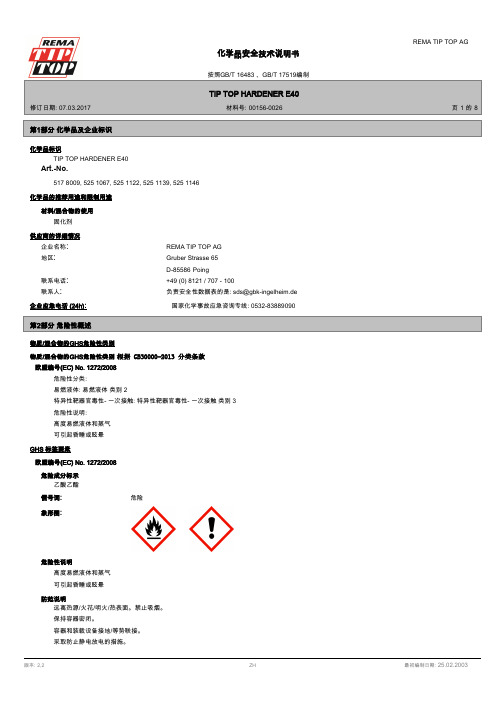
化学品的推荐用途和限制用途
材料/混合物的使用 固化剂
供应商的详细情况
企业名称: 地区:
联系电话: 联系人: 企业应急电话 (24h):
REMA TIP TOP AG Gruber Strasse 65 D-85586 Poing +49 (0) 8121 / 707 - 100 负责安全性数据表的是: sds@gbk-ingelheim.de
化学品安全技术说明书
修订日期: 07.03.2017
按照GB/T 16483 、GB/T 17519编制
TIP TOP HARDENER E40
材料号: 00156-0026
第1部分 化学品及企业标识
化学品标识 TIP TOP HARDENER E40
Art.-No.
517 8009, 525 1067, 525 1122, 525 1139, 525 1146
最初编制日期: 25.02.2003
TIP TOP HARDENER E40
修订日期: 07.03.2017
材料号: 00156-0026
戴防护手套/穿防护服/戴防护眼罩/戴防护面具。 如皮肤(或头发)沾染:立即脱掉所有沾染的衣服。用水清洗皮肤/淋浴。
其他危害 该蒸汽可能与空气混合形成爆炸性混合物。
对医生的特别提示 根据症状采取措施。
第5部分 消防措施
灭火介质 适合的灭火剂 泡沫、二氧化碳(CO2)、干粉灭火剂、水喷雾 不适合的灭火剂 喷水
特别危险性 火灾时会产生:
版本: 2,2
ZH
页2的8 数量
< 75 % < 30 %
最初编制日期: 25.02.2003
TIP TOP HARDENER E40
MSDS硝酸铁
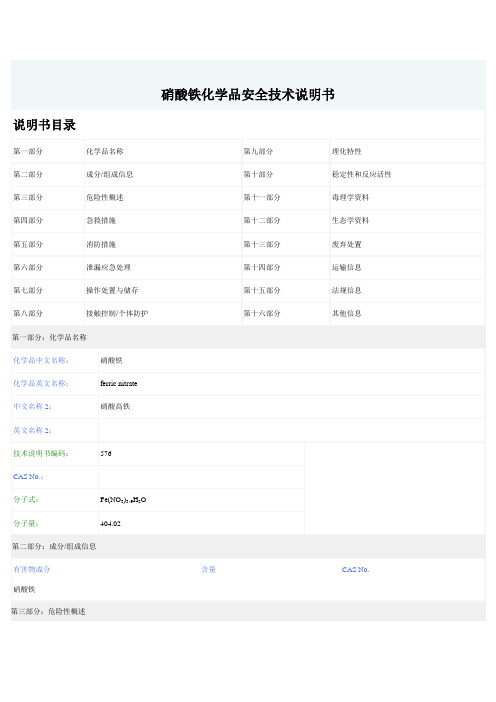
法规信息
化学危险物品安全管理条例(1987年2月17日国务院发布),化学危险物品安全管理条例实施细则(化劳发[1992] 677号),工作场所安全使用化学品规定([1996]劳部发423号)等法规,针对化学危险品的安全使用、生产、储存、运输、装卸等方面均作了相应规定;常用危险化学品的分类及标志(GB 13690-92)将该物质划为第5.1类氧化剂。
第九部分:理化特性
主要成分:
含量:分析纯≥13.6%。
外观与性状:
无色或淡紫色的单斜结晶,易潮解。
pH:
熔点(℃):
47.2
沸点(℃):
无资料
相对密度(水=1):
1.68
相对蒸气密度(空气=1):
无资料
饱和蒸气压(kPa):
无资料
燃烧热(kJ/mol):
无意义
临界温度(℃):
无意义
临界压力(MPa):
TLVWN:
未制定标准
监测方法:
工程控制:
生产过程密闭,加强通风。提供安全淋浴和洗眼设备。
呼吸系统防护:
可能接触其粉尘时,应该佩戴头罩型电动送风过滤式防尘呼吸器。必要时,佩戴自给式呼吸器。
眼睛防护:
呼吸系统防护中已作防护。
身体防护:
穿聚乙烯防毒服。
手防护:
戴橡胶手套。
其他防护:
工作完毕,淋浴更衣。保持良好的卫生习惯。
硝酸铁化学品安全技术说明书
说明书目录
第一部分
化学品名称
第九部分
理化特性
第二部分
成分/组成信息
第十部分
稳定性和反应活性
第三部分
危险性概述
第十一部分
毒理学资料
化学品安全技术说明书 BioRail EP 1

化学品安全技术说明书BioRail® EP 1依据GB/T 16483、GB/T 17519编制最初编制日期: 2023/9/15 版本: 1.0化学品中文名称:化学品英文名称: BioRail® EP 1企业名称: Whitmore标题: 制造商地址: USARockwall, Texas930 Whitmore Drive邮政编码: 75087电话号码: 1.972.771.1000电子邮件地址: ************************网站: 应急咨询电话: 化学紧急事故请拨 CHEMTREC 24小时全年无休美国与加拿大境内: 1.800.424.9300美国与加拿大以外: +1.703.527.3887(接受网络电话)化学品的推荐用途: 润滑剂、油脂和释放产品润滑剂化学品的限制用途: 没有更进一步的信息紧急情况概述GHS 危险性类别环境危害: 危害水生环境–急性危险类别2: 危害水生环境–长期危险类别3上述未涉及的其他危险性,分类不适用或无法分类标签要素危险说明 (GHS CN) : H401 - 对水生生物有毒H412 - 对水生生物有害并具有长期持续影响。
防范说明 (GHS CN)预防措施: P273 - 避免释放到环境中。
废弃处置: P501 - 处置内装物/容器至地方、区域、国家、国际规章规定的危险废弃物或特殊废弃物收集点。
物理和化学危险没有更进一步的信息健康危害没有更进一步的信息环境危害对水生生物有毒对水生生物有害并具有长期持续影响其他危害没有更进一步的信息产品形态: 混合物。
急救措施的描述吸入: 将人转移到空气新鲜处,保持呼吸舒适体位。
皮肤接触: 用大量清水清洗皮肤眼睛接触: 防范起见以水冲洗眼睛食入: 如感觉不适,呼叫解毒中心或医生。
最重要的症状和健康影响没有更进一步的信息对保护施救者的忠告没有更进一步的信息对医生的特别提示其他医疗意见或处理方式: 对症治疗灭火剂适用灭火剂: 雾状水干粉泡沫不适用灭火剂: 没有更进一步的信息特别危险性燃烧时可能产生的有毒有害燃烧产物: 可能释放有毒烟雾灭火注意事项及防护措施灭火方法: 没有更进一步的信息消防人员应穿戴的个体防护装备: 不得在没有适当防护装备的情况下尝试采取行动独立的呼吸防护装置完整的身体防护人员防护措施、防护装备和应急处置程序一般措施: 没有更进一步的信息: 没有更进一步的信息作业人员防护措施、防护装备和应急处置程序非应急人员应急处置程序: 对泄漏区域进行通风应急人员防护装备: 不得在没有适当防护装备的情况下尝试采取行动更多信息请参考第8部分“接触控制/个体防护”环境保护措施避免释放到环境中泄漏化学品的收容、清除方法及所使用的处置材料清洁方法: 没有更进一步的信息收容方法: 收集溢出物。
焦磷酸铁安全技术说明书英文
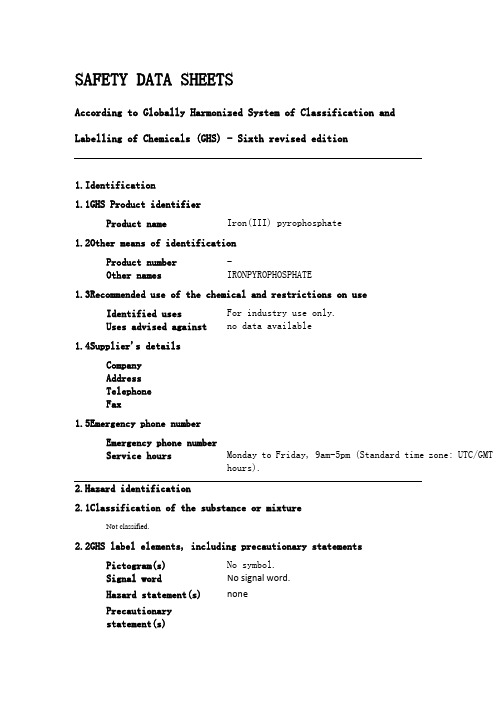
SAFETY DATA SHEETSAccording to Globally Harmonized System of Classification andLabelling of Chemicals (GHS) - Sixth revised edition1.Identification1.1GHS Product identifierProduct name Iron(III) pyrophosphate1.2Other means of identificationProduct number-Other names IRONPYROPHOSPHATE1.3Recommended use of the chemical and restrictions on useIdentified uses For industry use only.Uses advised against no data available1.4Supplier's detailsCompanyAddressTelephoneFax1.5Emergency phone numberEmergency phone numberService hours Monday to Friday, 9am-5pm (Standard time zone: UTC/GMThours).2.1Classification of the substance or mixtureNot classified.2.2GHS label elements, including precautionary statementsPictogram(s)No symbol.Signal word No signal word.Hazard statement(s)nonePrecautionarystatement(s)Prevention noneResponse noneStorage noneDisposal none2.3Other hazards which do not result in classificationnone3.1Substances4.1Description of necessary first-aid measuresGeneral adviceConsult a physician. Show this safety data sheet to the doctor in attendance.If inhaledIf breathed in, move person into fresh air. If not breathing, give artificial respiration. Consult a physician.In case of skin contactWash off with soap and plenty of water. Consult a physician.In case of eye contactRinse thoroughly with plenty of water for at least 15 minutes and consult a physician.If swallowedNever give anything by mouth to an unconscious person. Rinse mouth with water. Consult aphysician.4.2Most important symptoms/effects, acute and delayedno data available4.3Indication of immediate medical attention and special treatment needed, if necessaryno data available5.1Extinguishing mediaSuitable extinguishing mediaUse water spray, alcohol-resistant foam, dry chemical or carbon dioxide.5.2Specific hazards arising from the chemicalno data available5.3Special protective actions for fire-fightersWear self-contained breathing apparatus for firefighting if necessary.6.1Personal precautions, protective equipment and emergency proceduresUse personal protective equipment. Avoid dust formation. Avoid breathing vapours, mist or gas.Ensure adequate ventilation. Evacuate personnel to safe areas. Avoid breathing dust. Forpersonal protection see section 8.6.2Environmental precautionsPrevent further leakage or spillage if safe to do so. Do not let product enter drains. Dischargeinto the environment must be avoided.6.3Methods and materials for containment and cleaning upPick up and arrange disposal. Sweep up and shovel. Keep in suitable, closed containers fordisposal.7.1Precautions for safe handlingAvoid contact with skin and eyes. Avoid formation of dust and aerosols. Avoid exposure -obtain special instructions before use.Provide appropriate exhaust ventilation at places wheredust is formed. For precautions see section 2.2.7.2Conditions for safe storage, including any incompatibilitiesStore in cool place. Keep container tightly closed in a dry and well-ventilated place.8.1Control parametersOccupational Exposure limit valuesno data availableBiological limit valuesno data available8.2Appropriate engineering controlsHandle in accordance with good industrial hygiene and safety practice. Wash hands beforebreaks and at the end of workday.8.3Individual protection measures, such as personal protective equipment (PPE)Eye/face protectionSafety glasses with side-shields conforming to EN166. Use equipment for eye protection testedand approved under appropriate government standards such as NIOSH (US) or EN 166(EU).Skin protectionWear impervious clothing. The type of protective equipment must be selected according to theconcentration and amount of the dangerous substance at the specific workplace. Handle withgloves. Gloves must be inspected prior to use. Use proper glove removal technique(withouttouching glove's outer surface) to avoid skin contact with this product. Dispose of contaminatedgloves after use in accordance with applicable laws and good laboratory practices. Wash anddry hands. The selected protective gloves have to satisfy the specifications of EU Directive89/686/EEC and the standard EN 374 derived from it.Respiratory protectionWear dust mask when handling large quantities.Thermal hazardsno data availablePhysical state yellowish white powderColour no data availableOdour no data availableMelting point/ freezingno data availablepointno data availableBoiling point or initialboiling point and boilingrangeFlammability no data availableno data availableLower and upper explosionlimit / flammabilitylimitFlash point no data availableno data availableAuto-ignitiontemperatureDecompositionno data availabletemperaturepH no data availableKinematic viscosity no data availableSolubility no data availablePartition coefficientno data available n-octanol/water (logvalue)Vapour pressure no data availableno data available Density and/or relativedensityRelative vapour density no data availableParticle characteristics n o data available10.1Reactivityno data available10.2Chemical stabilityStable under recommended storage conditions.10.3Possibility of hazardous reactionsno data available10.4Conditions to avoidno data available10.5Incompatible materialsno data available10.6Hazardous decomposition productsno data availableAcute toxicity•Oral: no data available•Inhalation: no data available•Dermal: no data availableSkin corrosion/irritationno data availableSerious eye damage/irritationno data availableRespiratory or skin sensitizationno data availableGerm cell mutagenicityno data availableCarcinogenicityno data availableReproductive toxicityno data availableSTOT-single exposureno data availableSTOT-repeated exposureno data availableAspiration hazardno data available12.1Toxicity•Toxicity to fish: no data available•Toxicity to daphnia and other aquatic invertebrates: no data available•Toxicity to algae: no data available•Toxicity to microorganisms: no data available12.2Persistence and degradabilityno data available12.3Bioaccumulative potentialno data available12.4Mobility in soilno data available12.5Other adverse effectsno data available13.1Disposal methodsProductThe material can be disposed of by removal to a licensed chemical destruction plant or bycontrolled incineration with flue gas scrubbing. Do not contaminate water, foodstuffs, feed or seed by storage or disposal. Do not discharge to sewer systems.Contaminated packagingContainers can be triply rinsed (or equivalent) and offered for recycling or reconditioning.Alternatively, the packaging can be punctured to make it unusable for other purposes and thenbe disposed of in a sanitary landfill. Controlled incineration with flue gas scrubbing is possiblefor combustible packaging materials.14.1UN NumberADR/RID: Not dangerous goods.I MDG: Not dangerous goods.I ATA: Not dangerous good 14.2UN Proper Shipping NameADR/RID: unknownIMDG: unknownIATA: unknown14.3Transport hazard class(es)ADR/RID: Not dangerous goods.I MDG: Not dangerous goods.I ATA: Not dangerous good 14.4Packing group, if applicableADR/RID: Not dangerous goods.I MDG: Not dangerous goods.I ATA: Not dangerous good 14.5Environmental hazardsADR/RID: no IMDG: no IATA: no14.6Special precautions for userno data available14.7Transport in bulk according to Annex II of MARPOL 73/78 andthe IBC Codeno data available15.1Safety, health and environmental regulations specific for theproduct in questionInformation on revisionCreation Date Aug 12, 2017Revision Date Aug 12, 2017Abbreviations and acronyms•CAS: Chemical Abstracts Service•ADR: European Agreement concerning the International Carriage of Dangerous Goods by Road •RID: Regulation concerning the International Carriage of Dangerous Goods by Rail •IMDG: International Maritime Dangerous Goods•IATA: International Air Transportation Association•TWA: Time Weighted Average•STEL: Short term exposure limit•LC50: Lethal Concentration 50%•LD50: Lethal Dose 50%•EC50: Effective Concentration 50%Disclaimer: The above information is believed to be correct but does not purport to be all inclusive and shall be used only as a guide. The information in this document is based on the present state of our knowledge and is applicable to the product with regard to appropriate safety precautions. It does not represent any guarantee of the properties of the product. We as supplier shall not be held liable for any damage resulting from handling or from contact with the above product.。
硝酸铁的理化性质和危险特性
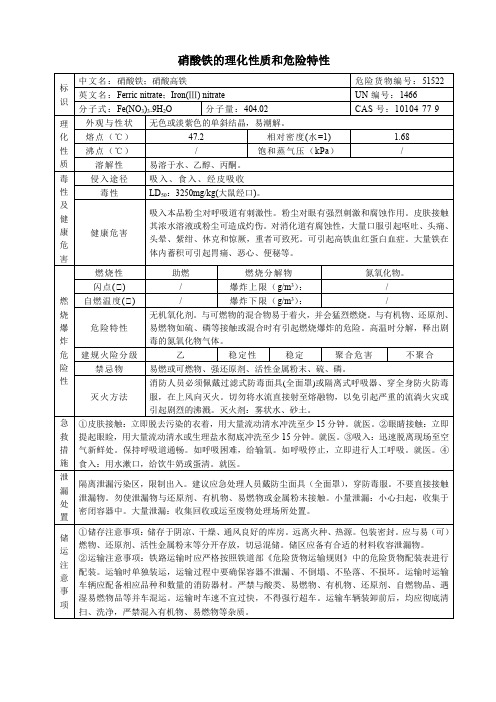
隔离泄漏污染区,限制出入。建议应急处理人员戴防尘面具(全面罩),穿防毒服。不要直接接触泄漏物。勿使泄漏物与还原剂、有机物、易燃物或金属粉末接触。小量泄漏:小心扫起,收集于密闭容器中。大量泄漏:收集回收或运至废物处理场所处置。
储运注意事项
①储存注意事项:储存于阴凉、干燥、通风良好的库房。远离火种、热源。包装密封。应与易(可)燃物、还原剂、活性金属粉末等分开存放,切忌混储。储区应备有合适的材料收容泄漏物。
稳定
聚合危害
不聚合
禁忌物
易燃或可燃物、强还原剂、活性金属粉末、硫、磷。
灭火方法
消防人员必须佩戴过滤式防毒面具(全面罩)或隔离式呼吸器、穿全身防火防毒服,在上风向灭火。切勿将水流直接射至熔融物,以免引起严重的流淌火灾或引起剧烈的沸溅。灭火剂:雾状水、砂土。
急救措施
①皮肤接触:立即脱去污染的衣着,用大量流动清水冲洗至少15分钟。就医。②眼睛接触:立即提起眼睑,用大量流动清水或生理盐水彻底冲洗至少15分钟。就医。③吸入:迅速脱离现场至空气新鲜处。保持呼吸道通畅。如呼吸困难,给输氧。如呼吸停止,立即进行人工呼吸。就医。④食入:用水漱口,给饮牛奶或蛋清。就医。
47.2
相对密度(水=1)
1.68
沸点(℃)
/
饱和蒸气压(kPa)
/
溶解性
易溶于水、乙醇、丙酮。
毒性及健康危害
侵入途径
吸入、食入、经皮吸收
毒性
LD50:3250mg/kg(大鼠经口)。
健康危害
吸入本品粉尘对呼吸道有刺激性。粉尘对眼有强烈刺激和腐蚀作用。皮肤接触其浓水溶液或粉尘可造成灼伤。对消化道有腐蚀性,大量口服引起呕吐、头痛、头晕、紫绀、休克和惊厥,重者可致死。可引起高铁血红蛋白血症。大量铁在体内蓄积可引起胃痛、恶心、便秘等。
- 1、下载文档前请自行甄别文档内容的完整性,平台不提供额外的编辑、内容补充、找答案等附加服务。
- 2、"仅部分预览"的文档,不可在线预览部分如存在完整性等问题,可反馈申请退款(可完整预览的文档不适用该条件!)。
- 3、如文档侵犯您的权益,请联系客服反馈,我们会尽快为您处理(人工客服工作时间:9:00-18:30)。
SAFETY DATA SHEETSAccording to Globally Harmonized System of Classification andLabelling of Chemicals (GHS) - Sixth revised edition1.Identification1.1GHS Product identifierProduct name iron(3+),trinitrate1.2Other means of identificationProduct number-Other names UNII-N8H8402XOB1.3Recommended use of the chemical and restrictions on useIdentified uses For industry use only. Agricultural chemicals(non-pesticidal),Intermediates,Plating agents and surfatreating agentsUses advised against no data available1.4Supplier's detailsCompanyAddressTelephoneFax1.5Emergency phone numberEmergency phone numberService hours Monday to Friday, 9am-5pm (Standard time zone: UTC/GMThours).2.1Classification of the substance or mixtureSkin corrosion, Category 1BSerious eye damage, Category 12.2GHS label elements, including precautionary statementsPictogram(s)Signal word DangerHazard statement(s)H314 Causes severe skin burns and eye damagePrecautionarystatement(s)Prevention P260 Do not breathe dust/fume/gas/mist/vapours/spray.P264 Wash ... thoroughly after handling.P280 Wear protective gloves/protective clothing/eyeprotection/face protection.Response P301+P330+P331 IF SWALLOWED: Rinse mouth. Do NOT inducevomiting.P303+P361+P353 IF ON SKIN (or hair): Take off immediately allcontaminated clothing. Rinse skin with water [or shower].P363 Wash contaminated clothing before reuse.P304+P340 IF INHALED: Remove person to fresh air and keepcomfortable for breathing.P310 Immediately call a POISON CENTER/doctor/…P321 Specific treatment (see ... on this label).P305+P351+P338 IF IN EYES: Rinse cautiously with water for severalminutes. Remove contact lenses, if present and easy to do. Continuerinsing.Storage P405 Store locked up.Disposal P501 Dispose of contents/container to ...2.3Other hazards which do not result in classificationnone3.1Substances4.1Description of necessary first-aid measuresGeneral adviceConsult a physician. Show this safety data sheet to the doctor in attendance.If inhaledIf breathed in, move person into fresh air. If not breathing, give artificial respiration. Consult a physician.In case of skin contactWash off with soap and plenty of water. Consult a physician.In case of eye contactRinse thoroughly with plenty of water for at least 15 minutes and consult a physician.If swallowedNever give anything by mouth to an unconscious person. Rinse mouth with water. Consult aphysician.4.2Most important symptoms/effects, acute and delayedInhalation of dust irritates nose and throat. Ingestion causes irritation of mouth and stomach.Dust irritates eyes and can irritate skin on prolonged contact. (USCG, 1999)4.3Indication of immediate medical attention and special treatment needed, if necessaryBasic treatment: Establish a patent airway. Suction if necessary. Watch for signs of respiratory insufficiency and assist ventilations if necessary. Administer oxygen by nonrebreather mask at10 to 15 L/min. Monitor for shock and treat if necessary ... . For eye contamination, flush eyesimmediately with water. Irrigate each eye continuously with normal saline during transport ... .Do not use emetics. For ingestion, rinse mouth and administer 5 ml/kg up to 200 ml of water for dilution if the patient can swallow, has a strong gag reflex, and does not drool. /Iron and related compounds/5.1Extinguishing mediaSuitable extinguishing mediaPersonnel protection: ... Wear positive pressure self-contained breathing apparatus whenfighting fires involving this material.5.2Specific hazards arising from the chemicalSpecial Hazards of Combustion Products: Toxic oxides of nitrogen and nitric acid vapor mayform in fires. Behavior in Fire: In contact with combustible materials, will increase the intensity of a fire. Apply water to cool containers or spilled material. (USCG, 1999)5.3Special protective actions for fire-fightersWear self-contained breathing apparatus for firefighting if necessary.6.1Personal precautions, protective equipment and emergency proceduresUse personal protective equipment. Avoid dust formation. Avoid breathing vapours, mist or gas.Ensure adequate ventilation. Evacuate personnel to safe areas. Avoid breathing dust. Forpersonal protection see section 8.6.2Environmental precautionsPrevent further leakage or spillage if safe to do so. Do not let product enter drains. Dischargeinto the environment must be avoided.6.3Methods and materials for containment and cleaning upEnvironmental considerations: Water spill: Neutralize with agricultural lime (CaO), crushedlimestone (CaCO3), or sodium bicarbonate (NaHCO3). Adjust pH to neutral (pH+ 7). Usemechanical dredges or lifts to remove immobilized masses of pollutants and precipitates.7.1Precautions for safe handlingAvoid contact with skin and eyes. Avoid formation of dust and aerosols. Avoid exposure -obtain special instructions before use.Provide appropriate exhaust ventilation at places wheredust is formed. For precautions see section 2.2.7.2Conditions for safe storage, including any incompatibilitiesStore in cool place. Keep container tightly closed in a dry and well-ventilated place.8.1Control parametersOccupational Exposure limit valuesno data availableBiological limit valuesno data available8.2Appropriate engineering controlsHandle in accordance with good industrial hygiene and safety practice. Wash hands beforebreaks and at the end of workday.8.3Individual protection measures, such as personal protective equipment (PPE)Eye/face protectionSafety glasses with side-shields conforming to EN166. Use equipment for eye protection testedand approved under appropriate government standards such as NIOSH (US) or EN 166(EU).Skin protectionWear impervious clothing. The type of protective equipment must be selected according to the concentration and amount of the dangerous substance at the specific workplace. Handle with gloves. Gloves must be inspected prior to use. Use proper glove removal technique(without touching glove's outer surface) to avoid skin contact with this product. Dispose of contaminated gloves after use in accordance with applicable laws and good laboratory practices. Wash and dry hands. The selected protective gloves have to satisfy the specifications of EU Directive 89/686/EEC and the standard EN 374 derived from it.Respiratory protectionWear dust mask when handling large quantities.Thermal hazardsno data availablePhysical state A violet crystalline solidColour no data availableOdour no data available47.2ºCMelting point/ freezingpointBoiling point or initial83ºC at 760 mmHgboiling point and boilingrangeFlammability no data availableno data availableLower and upper explosionlimit / flammabilitylimitFlash point no data availableno data availableAuto-ignitiontemperatureno data availableDecompositiontemperaturepH no data availableKinematic viscosity no data availableSolubility no data availableno data availablePartition coefficientn-octanol/water (logvalue)Vapour pressure49.8mmHg at 25°C1.684Density and/or relativedensityRelative vapour density no data availableParticle characteristics n o data available10.1Reactivityno data available10.2Chemical stabilityStable under recommended storage conditions.10.3Possibility of hazardous reactionsDangerous fire risk in contact with organic material. /Ferric nitrate nonahydrate/FERRICNITRATE is an oxidizing agent. Mixtures with alkyl esters may explode, owing to theformation of alkyl nitrates. Mixtures with phosphorus, tin(II) chloride or other reducing agents may react explosively [Bretherick, 1979 p. 108-109].10.4Conditions to avoidno data available10.5Incompatible materialsThey are powerful oxidizing agents which may cause violent reaction with reducing materials./Nitrates/10.6Hazardous decomposition productsToxic oxides of nitrogen & nitric acid vapor may form in fires. /ferric nitrate nonahydrate/Acute toxicity•Oral: LD50 Rat oral 3,250 mg/kg /Nonahydrate/•Inhalation: no data available•Dermal: no data availableSkin corrosion/irritationno data availableSerious eye damage/irritationno data availableRespiratory or skin sensitizationno data availableGerm cell mutagenicityno data availableCarcinogenicityno data availableReproductive toxicityno data availableSTOT-single exposureno data availableSTOT-repeated exposureno data availableAspiration hazardno data available12.1Toxicity•Toxicity to fish: no data available•Toxicity to daphnia and other aquatic invertebrates: no data available•Toxicity to algae: no data available•Toxicity to microorganisms: no data available12.2Persistence and degradabilityno data available12.3Bioaccumulative potentialno data available12.4Mobility in soilno data available12.5Other adverse effectsno data available13.1Disposal methodsProductThe material can be disposed of by removal to a licensed chemical destruction plant or bycontrolled incineration with flue gas scrubbing. Do not contaminate water, foodstuffs, feed orseed by storage or disposal. Do not discharge to sewer systems.Contaminated packagingContainers can be triply rinsed (or equivalent) and offered for recycling or reconditioning.Alternatively, the packaging can be punctured to make it unusable for other purposes and thenbe disposed of in a sanitary landfill. Controlled incineration with flue gas scrubbing is possible for combustible packaging materials.14.1UN NumberADR/RID: UN3264IMDG: UN3264IATA: UN3264 14.2UN Proper Shipping NameADR/RID: CORROSIVE LIQUID, ACIDIC, INORGANIC, N.O.S.IMDG: CORROSIVE LIQUID, ACIDIC, INORGANIC, N.O.S.IATA: CORROSIVE LIQUID, ACIDIC, INORGANIC, N.O.S.14.3Transport hazard class(es)ADR/RID: 8IMDG: 8IATA: 8 14.4Packing group, if applicableADR/RID: III IMDG: III IATA: III 14.5Environmental hazardsADR/RID: no IMDG: no IATA: no 14.6Special precautions for userno data available14.7Transport in bulk according to Annex II of MARPOL 73/78 andthe IBC Codeno data available15.1Safety, health and environmental regulations specific for theproduct in questionInformation on revisionCreation Date Aug 12, 2017Revision Date Aug 12, 2017Abbreviations and acronyms•CAS: Chemical Abstracts Service•ADR: European Agreement concerning the International Carriage of Dangerous Goods by Road •RID: Regulation concerning the International Carriage of Dangerous Goods by Rail •IMDG: International Maritime Dangerous Goods•IATA: International Air Transportation Association•TWA: Time Weighted Average•STEL: Short term exposure limit•LC50: Lethal Concentration 50%•LD50: Lethal Dose 50%•EC50: Effective Concentration 50%Disclaimer: The above information is believed to be correct but does not purport to be all inclusive and shall be used only as a guide. The information in this document is based on the present state of our knowledge and is applicable to the product with regard to appropriate safety precautions. It does not represent any guarantee of the properties of the product. We as supplier shall not be held liable for any damage resulting from handling or from contact with the above product.。
